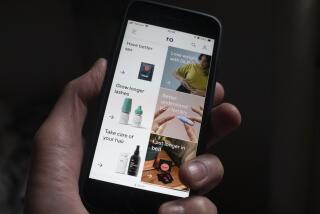JIM FORSYTHE : Medical Ad Firm in the Pink : Technology Has Created a Boom, Firm’s Founder Says
In recent years, there has been an explosion in the development of new drugs and medical technology. In addition, competition among hospitals and managed health-care organizations has heated up. And restrictions in the government’s reimbursement programs have added new pressures to the health-care industry.
In this highly charged atmosphere, health-care companies are turning in greater numbers to advertising agencies to help them attract customers and get their story across. While the professional market is still important, there is a greater emphasis on consumer advertising, a recognition of the patient’s expanding role in selecting health-care services and products.
Among the major advertising firms trying to meet the needs of the health-care field today is Forsythe Marcelli Johnson Advertising Inc., a Newport Beach advertising firm specializing in medical clients.
FMJ, which has 40 full-time employees and billings projected at almost $30 million this year, has grown rapidly since its founding in 1980. The company has won numerous awards from the Medical Marketing Assn.: For three years in a row, FMJ has swept the group’s national awards for creativity in health-care advertising.
The company is the largest independent health-care advertising agency west of the Mississippi.
Its client roster includes such major corporations as Bristol-Myers, 3M, Eli Lilly, Johnson & Johnson and Toshiba Medical Corp.
Jim Forsythe, the founder and majority owner of the company, has guided its growth as president and chief executive. He recently discussed trends in the business with Times staff writer Leslie Berkman.
Q. How large a demand is there for an advertising company that specializes in medical technology and health care?
A. According to Advertising Age, the advertising volume of the leading ad agencies that specialize in health care is increasing 50% faster than the volume of all other ad agencies. We estimate 1989 health-care advertising spending will be up 15 to 20% nationally.
Q. How long has that growth been occurring and why?
A. We have seen a big increase in health-care advertising over the past three to four years. There are two reasons. Technology is growing at an ever-increasing rate, and so there is a need to communicate that technology. Also, hospital reimbursement has become tighter in the past few years, especially for patients on MediCal and Medicare. That has had the effect of forcing providers to promote their services to privately insured patients.
Q. Do you advertise to consumers as well as health professionals?
A. Let’s define health-care advertising because it is a very broad field. Health-care advertisers are grouped in three categories: manufacturers of medical products or drugs; the providers of care, such as hospitals and clinics, and the area of managed care that consists of health maintenance organizations and preferred provider organizations.
In terms of size, the drug and technology segment is about a $2.1-billion a-year advertising market. The provider segment is about a $700-million market, and managed care is the same. But while managed-care advertising has been growing, hospital advertising recently has been declining.
Q. I thought hospital advertising had been increasing because of greater competition for patients?
A. It had until this past year when it declined slightly for the first time in many years. Hospital marketing research organizations believe the reason is that some hospitals have gone out of business because of an overall surplus of hospital beds.
Those who went out of business tended to be smaller hospitals. So although larger hospitals with 400 and more beds are increasing their amount of advertising, they are not making up for the smaller hospitals going out of business. Research outfits feel that advertising spending by hospitals, outpatient clinics and other providers will stabilize this year.
Meanwhile, our company figures that managed health-care organizations are increasing their advertising by about 20% a year, which is the same annual percent increase that the drug and technology field is experiencing.
Q. Are technology and health-care companies using the new emphasis on cost saving in their advertising?
A. That is one element of the story. In the area of technology, cost saving is a big aspect. But another aspect is providing a new technology or a drug that will cure something that was incurable.
The managed-care area really was driven by cost containment. It is alternative to indemnity insurance coverage.
Q. What is the most significant trend you see in health-care advertising?
A. Health-care products have proliferated. On the equipment and drug side, that has to do with technological evolution. On the provider side, hospitals have sharpened their focus and essentially repackaged what they have or created new services to take to the consumer.
One of our clients in Laguna Hills, Saddleback Memorial Medical Center, has launched a women’s hospital. They are making a multimillion-dollar investment in order to target their services.
Five years ago, FMJ created what was at that time the first adult psychiatric advertising campaign in the nation that advertised directly to consumers. We did it for Capistrano by the Sea Hospital down in Dana Point. Now those kinds of advertisements are very commonplace.
Q. Why has advertising to consumers become more prevalent? Is it because patients are making more decisions about their health, rather than relying entirely on the recommendation of physicians?
A. Yes. Hospitals are learning that consumers are very much taking their own route now, and they must communicate to these consumers if they are going to get their business. Consumers are much better informed, and one reason is because of advertising.
Q. How much consumer advertising does your company do?
A. Our advertising is probably 50-50 between the professional audience and the consumer audience. So we do a lot of radio and television to the consumer audience and a lot of trade journal and direct mail advertising to the professional.
Q. What are some medical products that you advertise to consumers today that you once wouldn’t have thought of being appropriate for consumer advertising?
A. We are talking to patients with eye problems and advising them of products available to them through a physician for surgery. We might be talking about an interocular lens to the consumer on one hand and to the doctor on the other.
Q. Because hospitals generally consider Medicaid reimbursements inadequate, they are wooing private-paying patients. How do you help them attract such patients?
A. It’s tough because everyone is trying to attract that type of customer. One of the tactics being used is to develop hospital services that appeal to patients who have the income or insurance to pay. Elective-surgery centers, wellness programs, upgraded birthing facilities are some of the services we’re seeing advertised now. It’s what we call “niche marketing.”
For example, there is a billboard on Santa Monica Boulevard we created for a hospital to advertise in vitro fertilization--test-tube babies. Now that’s a very specialized service. But the billboard was effective in attracting women who wanted to become pregnant and could also afford the substantial cost of this type of program.
Q. Do you think consumers get confused by all the competing hospital advertising?
A. There is some criticism of advertising that is warm and fuzzy and does not give specific information to the consumer. Some hospitals are guilty of that.
Q. What is a warm and fuzzy ad?
A. One that says “we care, we really care, we care a lot. Our nurses care, our doctors care.” Without describing a specific benefit. There are still hospitals that promote that way. But we are seeing fewer and fewer warm and fuzzy ads because they just don’t cut it with today’s well-informed, often skeptical consumer.
Q. But isn’t there also a lot of duplicate advertising among hospitals each saying it has a top-notch cancer center or maternity service?
A. There is some sameness, and I think that is one of the reasons why there are advertising agencies trying to do something creative. We are a strong proponent of “reason why” advertising. By that I mean advertising that is highly informative. We want our audience to be smarter after they’ve seen one of our ads. But to do that we have to cut through the clutter of everybody else’s advertising.
Q. What would be an example of a very creative medical ad?
A. For instance we have an ad for a heart valve that has a low-slung design to create more normal blood flow. The ad is a picture of white swans camouflaged on a field of snow, which is a rather unusual way to advertise a heart valve to a cardiovascular surgeon. The message was we had a low-profile product and nature has taught us that is good. The more you look, the more fascinated you become. That is creativity.
Q. Do you work with hospitals when they are deciding what services to develop or advertise?
A. It varies enormously depending on the sophistication and resources of the client. One of our clients, Long Beach Memorial Medical Center--with 998 beds its the second-largest non-government hospital west of the Mississippi--has very sophisticated marketing people who do a lot of research and have significant funds to commit to different programs. With them we are involved from the very inception of a marketing plan. We discuss what services are profitable or not and what the community needs.
Q. How do you measure results from health advertising?
A. It is pretty easy. With medical product companies, you ring up sales. The same thing is true in managed care. Maxicare, a managed-care organization, is one of our clients. The company is based in Los Angeles and operates in seven states. We run radio and television and newspaper ads in the company’s individual markets, and it watches enrollment in each market to see if the advertising paid for itself.
Q. What particular expertise do you need in medical advertising that is not required for other kinds of advertising?
A. In the drug and technology field it requires a knowledge of how to communicate with a very professional audience. I may be talking to a plastic surgeon or someone who transplants hearts. They are rather special people and require a special understanding of what motivates them. Also, doctors are very hard to reach because they are very busy people. It is getting more difficult for salesmen even to talk to a doctor. So we are using more telemarketing and teleconferencing.
Q. Is it necessary for you to spend a lot of time learning about new medical technologies?
A. Most of our advertising is done on a national basis, and there you learn a new technology almost all the time. Typically we spend weeks getting up to speed.
Q. Do you think that eventually the majority of physicians will advertise their practices?
A. More and more, I think physicians as a group are accepting advertising. We have seen that with the increase overall in hospital advertising over the years. There are a lot of physicians who sit on the board of any given hospital, and they have come to recognize a hospital’s need to advertise. I think more physicians also are moving in that direction as far as their individual practices are concerned. There are still a lot of physicians who feel advertising is not appropriate, but I think the pendulum is slowly swinging the other way.
Q. Has your firm been brought in as a trouble-shooter by companies that are having problems?
A. Yes. The one that comes to mind is the VLI Corp., maker of the Today sponge contraceptive. While it is now part of American Home Products in New York, VLI was previously based in Irvine. They came to us abut two years ago when their sales plateaued. They had been advertising strictly to the consumer. They had not taken the time to communicate with obstetricians and gynecologists.
They came to us and said, “Maybe we made a mistake and should do some professional advertising.” We concurred with that and produced a campaign. We used direct mail to obstetricians and gynecologists, clinics and family physicians that did a lot of birth-control counseling.
Q. Did you find out what physicians thought of the sponge?
A. If they were aware of the product, it was in a negative sense. A patient might come in and say she got pregnant although she was using the sponge. Also there were some reported cases of toxic shock syndrome that the physicians had read about in medical journals. So we took some positive information to physicians for the first time. And it was very successful. The company got many physician requests for literature and samples of the product.
Q. Are you restricted by federal regulations on how you can advertise a product?
A. What is interesting is that there are more regulations about what we can say to a doctor than about what we can say to a consumer. Here you have an incredibly well-educated physician reading or listening to information that is much more regulated, principally by the Food and Drug Administration, telling you what you can and cannot say and what you must say.
Q. Do you have lawyers who check the ads before they run?
A. No. But most clients in the medical field have legal counsel who review any advertising.
Q. Aren’t there regulations governing advertising to consumers?
A. There are comparatively very few. It seems rather funny. But that is the way it is. Of course, you cannot lie and you can’t intentionally mislead.
Q. Why is advertising to physicians so strictly regulated?
A. It goes back about 25 years when thalidomide, a sedative, was found to be responsible for severe birth deformities when taken during pregnancy. Thalidomide was the political football that triggered a requirement on manufacturers of all prescription drugs to communicate what was called “full disclosure” advertising to physicians. It required disclosures of all the negative side effects with warnings in the advertising. If 50% of your ad had to do with positive things, 50% had to talk about the negatives.
Q. Would you advocate more restrictions on advertising to consumers?
A. I think by and large in the health-care area, advertising is not misleading. I think it may not always be well focused or informative, but I don’t think you can legislate information. I think by and large, the fewer regulations, the better. I think there could be less regulation on the professional side.
More to Read
Inside the business of entertainment
The Wide Shot brings you news, analysis and insights on everything from streaming wars to production — and what it all means for the future.
You may occasionally receive promotional content from the Los Angeles Times.










